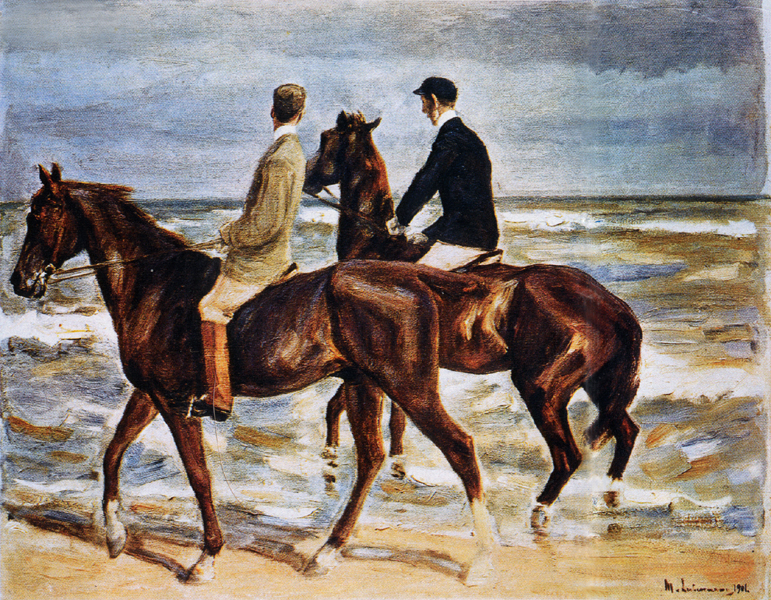News:
Bavaria and Germany Move to Dismiss Gurlitt Litigation, But Raise Questions About Why They Are Resisting a Lawsuit Over Painting that Task Force Recommended They Restitute to David Toren
By Nicholas O'Donnell
To date, only one lawsuit has been filed in the United States related to the seizure from Cornelius Gurlitt’s apartment of some 1,280 works of art, a story that broke a year ago with the concern about the objects’ Nazi-looting connections via his father Hildebrand Gurlitt (the view here last winter was that the longer Germany failed to address the situation comprehensively, the more likely such U.S. litigation became). That lawsuit, brought by David Toren, seeks the return of Two Riders on the Beach (Zwei Ritter am Strand), by Max Liebermann. Germany and Bavaria moved to dismiss the case yesterday, which is particularly puzzling given that among the very few determinations made by the Gurlitt Task Force (in August), it is that the Liebermann should be returned. The cynical view is that they are looking to forestall future claims, but it is past time for the painting to be returned.

Toren, a resident of New York, left Germany at age 14 in 1939. His great uncle David Friedmann lived in Breslau, Silesia (now Wrocław, Poland). The Nazis sought out and seized Friedmann’s art collection in 1939-40, including the Liebermann painting. Toren seeks recovery under several theories, but they fall into two groups: the first is bailment, the other is wrongful possession. The latter claims that he is the true owner, and that Germany is wrongfully in possession of the work. Under common law, he could recover the painting, its value, or some combination. In other words, if the work was his uncle’s, and he is his uncle’s heir, whoever has it now is wrongfully in possession. The bailment argument rests on the idea that when Bavaria seized the paintings from Gurlitt—but without any assertion that Germany or Bavaria is the owner—it did so for the benefit of the true owners. Thus, Toren argues, the seizure was a bailment that was breached when Toren demanded the painting back but was refused.
The recent motion to dismiss targets Toren’s assertion of jurisdiction under the Foreign Sovereign Immunities Act. Countries, states, and other sovereigns are generally immune from lawsuits unless they either consent, or a statute abrogates that immunity. 28 U.S.C. § 1605(a) lists those potential exemptions from immunity. Many art restitution cases rely on the “expropriation exception,” of § 1605(a)(3), where the property at issue was taken in violation of international law, and the sovereign is also engaged in commercial activity in the U.S. The Altmann, Malevich, and Cassirer cases all rely on this, for example.
Toren relied on a different provision, § 1605(a)(2), which exempts the sovereign from immunity in a case:
(2) in which the action is based upon a commercial activity carried on in the United States by the foreign state;
or upon an act performed in the United States in connection with a commercial activity of the foreign state elsewhere;
or upon an act outside the territory of the United States in connection with a commercial activity of the foreign state elsewhere and that act causes a direct effect in the United States.
Toren alleged in the Complaint that Bavaria’s act of seizure was just such an “act outside the territory of the United States in connection with a commercial activity of the foreign state elsewhere and that act cause[d] a direct effect in the United States,” specifically, that Toren was damaged in the United States when Bavaria refused to honor its bailment.
Germany and Bavaria have now challenged this assertion in three primary ways. One, they argue, the Gurlitt seizure, while obviously an act outside the United States, was not “in connection with a commercial activity.” Rather, they say, the seizure was a sovereign act in connection with Gurlitt’s currency and tax investigation. Second, they dispute that Toren’s presence in the United States is sufficient to constitute the necessary “direct effect in the United States.” Lastly, the defendants contend, the assertion of a bailment agreement is insufficiently pleaded to warrant further litigation.
These arguments were hardly a surprise in an FSIA case, but one can’t help but wonder what it is all for in this case. That is because nearly two months ago, the Gurlitt Task Force issued only its second public recommendation—specifically, that the Liebermann be returned to Toren. Bavaria, for its part, agreed to follow the Task Force recommendations as part of its agreement with Gurlitt shortly before his death. So even if, hypothetically, the Kunstmuseum Bern accepts its appointment as Gurlitt’s heir but then accuses Bavaria of having given back its (via Gurlitt) property, it would have no argument because it does no more than stand in Gurlitt’s shoes. That is not to suggest that the Kunstmuseum is even entertaining such a thing, but it would be the only person or entity with standing to challenge any restitution by Germany. So why is Germany—having just announced its Center of Cultural Property Losses with great fanfare—delaying that restitution simply to contest this lawsuit?
The guess here is that Germany knows more lawsuits are coming. And if it can make some favorable law in a case that, in effect, it’s going to lose anyway, it may have something to fall back on if challenged over something it does not want to restitute.
The easiest, and best, thing to do would simply be to return the painting. Toren would presumably drop the lawsuit at that point, and if not, it would likely be moot. It’s been at least 75 years since he’s seen the painting. That seems quite long enough.
http://www.artlawreport.com/2014/10/10/bavaria-and-germany-move-to-dismiss-gurlitt-litigation-but-raise-questions-about-why-they-are-resisting-a-lawsuit-over-painting-that-task-force-recommended-they-restitute-to-david-toren/


